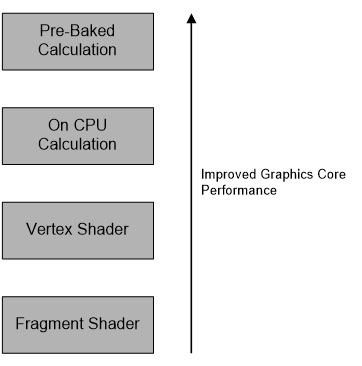Do Move Calculations ‘Up the Chain’¶
Reduce the overall number of calculations by moving them earlier in the pipeline where there are fewer instances to process.
By performing calculations earlier in the pipeline, the overall number of operations can be reduced, and therefore the workload can also be substantially reduced. Generally in a scene there are far fewer vertices than fragments that need to be processed. This means processing per vertex, instead of per fragment, would greatly reduce the number of calculations. One use case, for example, could be to perform per vertex lighting instead of per pixel lighting.

It is also possible to consider moving calculations off the graphics core altogether. Although the graphics core may be able to perform operations far more rapidly than the CPU can, it would be even faster for the CPU to perform an operation just once instead of the allowing the operation to be performed for many vertices on the graphics core.
To take the concept even further, consider performing calculations offline by baking values into the scene, effectively replacing expensive run-time calculations with a simple lookup. For example, replacing real-time lighting with light maps for static objects in a scene, such as terrain, buildings and trees can be a particularly effective compromise. This substantially improves performance, and in many cases provides higher quality lighting than would be possible to calculate at run-time.

